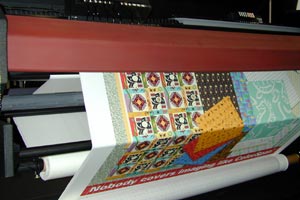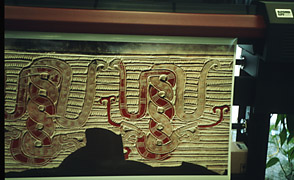Nicholas Hellmuth reports on his five year's experience with ColorSpan printers.
 |
During the years 1997-2003, this kind of water-based printer was a popular choice for a professional photo studio (photo lab), print shop, copy center, or advertising bureau. In the intervening years new ink chemistries (eco-solvent, mild-solvent, UV-cured) have arrived. So the entire situation has changed. But people still ask about printers made in the 1990's because they are still offered on eBay. Hence we maintain our old web pages from these early years.
If you need help deciding what wide format color printer to buy, send an e-mail to the review editor, Nicholas Hellmuth, contact Please be sure to mention what kind of images you reproduce, what your applications are, your level of experience such as whether you are new to digital printing, and what printers did you consider before reading the reviews on this site. Indicate roughly your budget since it makes little sense to lust after a printer that is overly costly. We prefer to recommend cost-effective printers that produce photo-realistic quality with long-lasting colors using archival inks.
For museums a printer such as this would be an asset in fund raising. Museums could do exhibits more economically if the curators and in-house photo staff had access to a wide-format printer. With a local network everyone in the building can easily print from a single printer. Just send your files over the network.
ColorSpan makes a wide selection of fine printers. The first model we tried was the Ilford IJT from Ilford Imaging. This is the ColorSpan DisplayMaker HiRes with 8-color technology that we used five years ago. The 8-colors are what give it the High Resolution. Agfa used to market the ColorSpan under the name Agfa Montana.
Summer 2003 we received our second ColorSpan printer in our own facilities at Bowling Green State University, the ColorSpan Mach 12. We acquired the Mach 12 after our favorable experiences for a year with the DisplayMaker XII.
| Archiva
inks from Ilford are specially formulated to last as
long as possible.
Archive inks have a well deserved reputation for brightness. During the test what impressed me the most was how true the colors are when printed on the ColorSpan. Unfortunately the flash used to take this snapshot was not wide enough to cover the field of view of the wide angle lens. |

|
Many different RIPs work for the ColorSpan. However for each of our two ColorSpan printers we opted for their own hardware RIP from ColorSpan. This way we get all the color management and ICC color profiles built in. Our print shop at the university uses both ColorSpan printers all the time. We are fully content with them both. The X-12 is even better but we don't have this yet.
Don't try to buy one of these printers over the internet and try to install it yourself. A ColorSpan is a printer where you need the printer, the RIP, the media, the inks, and all their ICC profiles together in one package. This is an integrated system, the only way to set up a printer of this nature. Just be sure that you realize these complex printers may need an extended warranty (which can cost several thousand dollars). The warranty is needed for as long as you own the printer, since you may need technical help and replacement of parts. ColorSpan is a complex technical printer; this is not something for a one-person or husband-and-wife team, unless you need the high quality and can afford the correspondingly cost of maintenance.
Take the speed statistics with a grain of salt (which means reduce them). Remember the rule, fast speed = low dpi, low dpi = less quality. Hence, fast speed = less quality.
Naturally what you want is slow speed = the highest quality. The ads show you the high quality, brag a bit about the high speed, and the reader loses track and presumes the high quality is of course also available at the high speed. No, its not like that. Once said, the ColorSpan sure is faster than any poky piezo printhead machine.
If you are good with electronics, if you have already run a printing company (with traditional presses), or if your company is large enough to have a person who likes to work on equipment such as a ColorSpan printer, then you should consider this printer. We recommend, however, only a factory-new printer. If a demo or reconditioned, then we recommend under the agreement (written agreement) that it will be replaced or purchase price refunded in full if the printer does not function as advertised. You will need a maintenance agreement for as long as you intend to own the printer. Indications from actual users are that these printers require occasional replacement of major and costly electronic parts, which is covered by the service agreement. Actually our first ColorSpan was reconditioned and it worked just fine. Required only a single service call, and that was the result of a student, with zero experience, accidently trashing part of the machine in an over exuberient attempt to clean up his recent printing foible.
What are your alternatives? Roland offers good quality but much slower. Roland is supposed to run around the clock, which is why it costs more than the Epson. Roland also offers archival inks which are more mature than any new inks. Downside is the Roland's propensity to banding, printhead disabilities, and slowness. This can pop up at any time and ruin your images. Which means can you really trust to run a piezo printer unattended all night long?
Another alternative is the HP 3000, 3500, or 3800CP, after all, these models use the same heads as the ColorSpan. ColorSpan is wider, somewhat faster, and noticeably higher dpi. HP DesignJet printers, however, work seemingly forever with no maintenance and you can buy two for the price of a ColorSpan. But the color output of the ColorSpan's eight colors really pops. We get more favorable comments on eight color output from the ColorSpan than from any mere six color printer.
The new Esprit model of ColorSpan changes this. Now you get the same quality (eight colors) yet for the price of an HP DesignJet. Of course HP itself has upped the ante by producing its own 1200 dpi six color printer, the HP 5000ps. But then ColorSpan came out with their Mach 12, which has the identical printheads as the HP 5000ps but the ColorSpan offers either dual six colors (for fast mode) or eight colors (for more color depth). We are going for the full 12-color version of the Mach 12.
If you want to knock people's eyes out with quality, at an art exhibit, trade show, or whatever, then you need those extra dpi offered by ColorSpan's eight or twelve color advantage. We will be doing an in-depth analysis of the ColorSpan as we become more familiar with the Mach 12, so check back later this year for more information.
If you have read a lot of the FLAAR reviews you can probably note that my favorite for entry-level through mid-level is the HP and my favorite for high-end is the ColorSpan. I like the Mimaki and Mutoh but the ColorSpan is ideal for a sign shop. If I won the lottery, then I would also want a Cymbolic Sciences LightJet or Durst Lambda (about a quarter of a million dollars). In comparison the ColorSpan is a bargain.
ColorSpan makes a range of impressive printers, from DisplayMaker Series XII wide format printer to the Mach 12 which offers an apparant 1800 dpi color print. The newest model is the X-12.
ColorSpan was bought by a new company about 3 years ago, MacDermid. MacDermid ColorSpan has a policy of taking better care of the customer and attending to maintenance and service. I have kept an eye on ColorSpan, the company and its printers, for several years. One of their models, the Esprit, costs half of previous models and gives the same legenday quality. For additional information on ColorSpan printers, contact Bruce Butler at e-mail [email protected].
Most recently updated July 31, 2007.
Previous updates: May 16, 2003, June 24, 2002, July 10/2001.